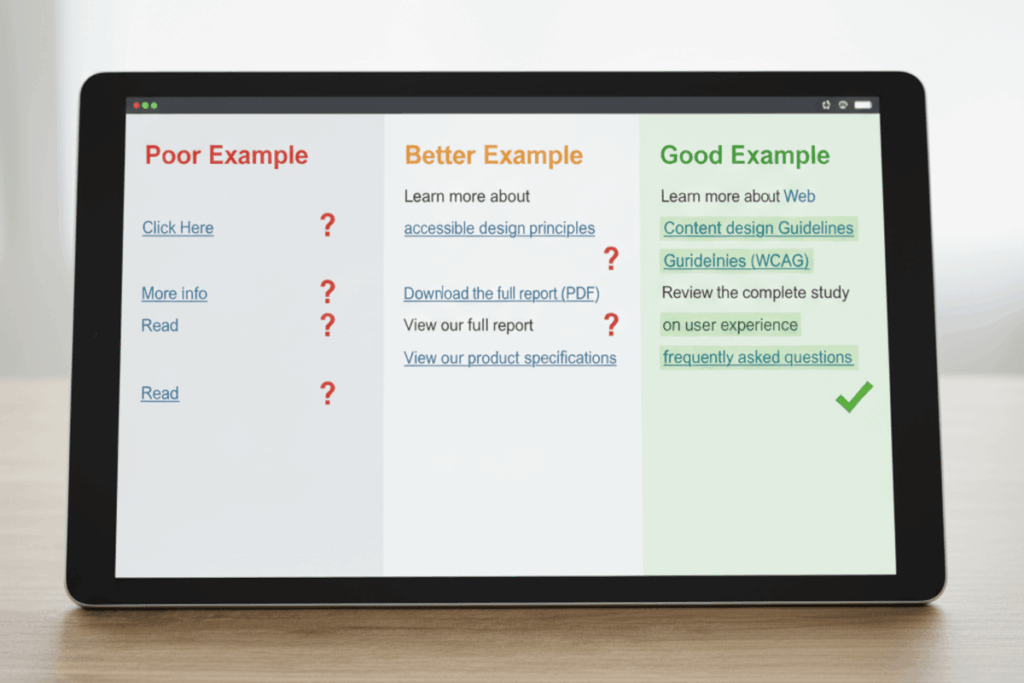Note: The creation of this article on testing Link Purpose (In Context) was human-based, with the assistance of artificial intelligence.
Explanation of the success criteria
WCAG 2.4.4 Link Purpose (In Context) is a Level A conformance level Success Criterion. It ensures every link clearly communicates its destination, whether through the link text itself or its surrounding context. It helps users understand where a link will take them before they click, tap, or activate it. The result? Less confusion, greater trust, and a smoother navigation experience for everyone.
Clear link purpose is not only a matter of accessibility, it’s a hallmark of thoughtful design. When implemented well, it enhances comprehension, supports assistive technologies, and creates a more intuitive journey through content. For organizations, it also reinforces credibility by signaling attention to detail and respect for users’ time and effort.
Who does this benefit?
The value of WCAG 2.4.4 extends far beyond compliance. It directly empowers a wide range of users:
- Screen reader users benefit when link text conveys purpose without requiring them to explore surrounding content, allowing for faster, more efficient browsing.
- Keyboard-only users rely on clear, descriptive link text to decide which links to follow as they navigate sequentially through a page.
- Users with cognitive or learning disabilities depend on predictable and descriptive cues that minimize confusion and support memory, attention, and understanding.
- Users with low vision using screen magnifiers often view only a portion of a page; clear link text ensures they don’t lose context or direction.
- And ultimately, all users benefit from intuitive, self-explanatory links that enhance usability and reduce friction.
In essence, clear link purpose isn’t just an accessibility best practice, it’s good design that benefits everyone.
Testing via Automated testing
Fast, scalable, and efficient, automated tools can quickly flag non-descriptive link text such as “click here” or “read more,” and identify patterns across an entire site. This step is ideal for spotting obvious issues and establishing a broad accessibility baseline. But automation alone can’t determine whether context makes a vague link meaningful or if a link’s purpose is truly clear to users, it lacks the nuance of human comprehension.
Testing via Artificial Intelligence (AI)
Artificial Intelligence adds a layer of sophistication. AI can analyze the surrounding text, headings, and structural cues to infer meaning and identify when a link might still be ambiguous. It learns from language patterns and can even suggest clearer alternatives, bridging the gap between technical detection and user-centered understanding. However, AI still has limits, it doesn’t fully grasp human intent or the subtle mental effort required to interpret unclear phrasing, particularly for users with cognitive challenges.
Testing via Manual Testing
Human testing brings the critical perspective that machines can’t replicate. Skilled testers use both visual review and assistive technologies, such as screen readers, to evaluate whether each link’s purpose is unmistakably clear, even when taken out of context. This process captures the subtleties of tone, structure, and usability that define real accessibility. The trade-off, of course, is time, manual testing is more resource-intensive and less scalable.
Which approach is best?
No one method of testing WCAG 2.4.4 Link Purpose (In Context) is sufficient on its own. The most effective strategy blends all three methods, using each where it excels.
Start with automated testing to uncover large-scale issues and patterns across pages. Then leverage AI-based analysis to interpret meaning and identify context-driven concerns that automation misses. Finally, apply manual testing to validate clarity and usability from a real user’s perspective, ensuring that every link truly communicates its intent.
This hybrid approach unites the best of technology and human judgment. Automation brings speed and breadth, AI delivers contextual intelligence, and manual testing ensures authentic, human-centered validation. Together, they create a powerful framework for ensuring that link purpose is not only compliant but also meaningful, turning accessibility testing into a catalyst for better design and better user experiences.
Related Resources
- Understanding Success Criterion 2.4.4 Link Purpose (In Context)
- A11y 101: 2.4.4 Link Purpose (In Context)
- Using Link Titles to Help Users Predict Where They Are Going
- WebAIM Techniques for Hypertext Links
- Providing link text that describes the purpose of a link
- Providing link text that describes the purpose of a link for anchor elements
